Competitive Analysis: How it works and how to leverage your insights (A SEO perspective)
Conducting a Competitive Analysis – the ultimate 2020 guide
- To understand the importance of competitive analysis for founders and startups
- To understand the full benefits of a competitive analysis
- To realize how you will find the most relevant SEO Opportunities in the process
- To learn how to conduct one for your own business – hands-on & step-by-step
- To learn how to apply the SERP method
- To learn how to leverage digital tools over the manual approach

Introduction
Have you ever been enrolled in business school? Yes?
Then you – just like me – have probably studied the concept of a “competitive analysis” more often than you would like to admit. 30 times in 30 different exams? Easily.

But the big question is, when was the last time you actually conducted one in “real life”?
Exactly, probably never.
However, what if I told you that analyzing your competitive landscape is actually one of the skills that turn out to be extremely useful even after graduating?
In fact, understanding your environment is one of the most crucial factors if you are interested in positioning your business for success in the long run – no matter if you operate in a large enterprise or lead a small startup.
While big companies often have numerous people dedicated to the job, founders and small startup teams do not yet have the respective manpower and tend to find themselves in between a million tasks. 🤪
Being so focused on structuring and growing your own business often leaves little to no space for the look outside the window.
But that’s a huge mistake – especially for young firms!
Get the full SEO Checklist and start taking ALL the steps you need to in order to rank at the top of Google.

John Abott The SEO Checklist by SEOBuddy is awesome. It doesn’t just tell you what you need to do, it walks you through the process.
What exactly is a Competitive Analysis and why do you need it?
A competitive analysis is a structured evaluation of your business environment. It has the goal to understand your value-add and position in the market compared to other players in the field.

What are they good at? What are their weaknesses? And most importantly: How do I make sure that they are not stealing away my customers and business? 🤷♀️ In today’s hyper-competitive environment, nobody (especially not younger companies) can afford to share their piece of cake with someone else.
While it’s rather tempting to avoid the look outside completely (and there are a million other things to do in the early phases anyways), it is extremely important to do so on a regular basis. Because, at the end of the day, you do not want to end up as a boiled frog.
Wait, what? What does a frog have to do with my business? 🤔
More than you might think!

The boiled frog is one of the few concepts I (actually!) remember from university.
It is simple yet pretty interesting:
You probably haven’t spent a second in your life thinking about what happens if you throw a frog into boiling water. I’ll tell you what happens: It will immediately jump out – obviously trying to avoid the deadly water.
But now the cool part: If you put a frog in cold water and THEN heat it up, it will stay without a movement, not realizing it is boiling to death (at least that’s what they say – thank god I cannot talk from own experience 😉)
You may now ask – and that’s fair – how this little story is related in any way with the topic of this article.
The “boiled-frog concept” is commonly used in a business environment when companies only focus on themselves, not looking at a slowly (but surely) changing environment. Closing your eyes and not considering your competitive landscape can be fine – for a while.
Getting caught up in everyday business, not noticing the water around gets warmer and warmer happens quickly. Until one day you wake up – and you realize you are a boiled frog yourself.
Conducting a competitive analysis is your way out of this situation. And on top it has a number of advantages for your daily operations as well as for your long-term strategy.
What are the benefits of a Competitive Analysis?
- Understand the competitive landscape and your position within the market,
- Learn from your environment,
- Unveil market trends and stay up to date,
- Identify gaps in the market,
- Get inspired!
- Find the best SEO Opportunities.

Well, so far, so good. Now, what if someone told you to do a competitive analysis on the spot – can you recall how exactly that worked?

Let’s refresh our brains really quick!
How to conduct a Competitive Analysis?
Before you start – identify your keywords

Before you start looking at your rivals, it is absolutely crucial that you understand WHAT market you are in. A simple yet effective way for founders to determine their “area of operation” is to ask yourself, which keywords describe your business best?
Try to come up with at least 5 keywords and write them down!
Important: Keyword Research is a topic on its own and deserves more attention than what I’m able to mention within the scope of this article.
However, make sure the keywords you come up with are actually connected to significant search volume so you don’t waste your time! Identifying the right keywords is the baseline of a competitive analysis and decides over the success of the whole endeavour.
I can recommend this article: https://backlinko.com/keyword-research to deepen your knowledge on keyword research and find keywords that are actually relevant!
The method – conduct a SERP analysis
Once you know your keywords, the next obvious step is…? 🤔
Correct – type that keyword into Google and hit the search button. 🧐 Within a split second you will find the results that Google thinks are most relevant to your search term.
Very convenient.
Now the actual work starts: The old-fashioned way is to
- Manually go through the results one by one,
- Identify and dissect the web pages popping up,
- Take notes on relevant findings (for example in a spreadsheet).
In professional language you call this procedure SERP (Search Engine Result Page) analysis.

While this manual SERP approach is a legitimate method, it can be tedious. 😴
Thank god we live in a time where there is a tool for (almost) everything.
One very effective and useful platform to help you with your SERP evaluation is SEO Buddy. Using SEO Buddy is an easy yet very smart way to organize and conduct your competitive analysis, step by step.
The output – structure your findings
1. Identify your competitors
While doing the SERP analysis, you will discover a bunch of information. But no worries, let’s go through it step by step to extract all important information. The first goal is to identify all the relevant competitors ranking for that keyword and to understand how you rank against them.
SEO Buddy for example helps you to create (and then maintain!) a list of all your competitors:
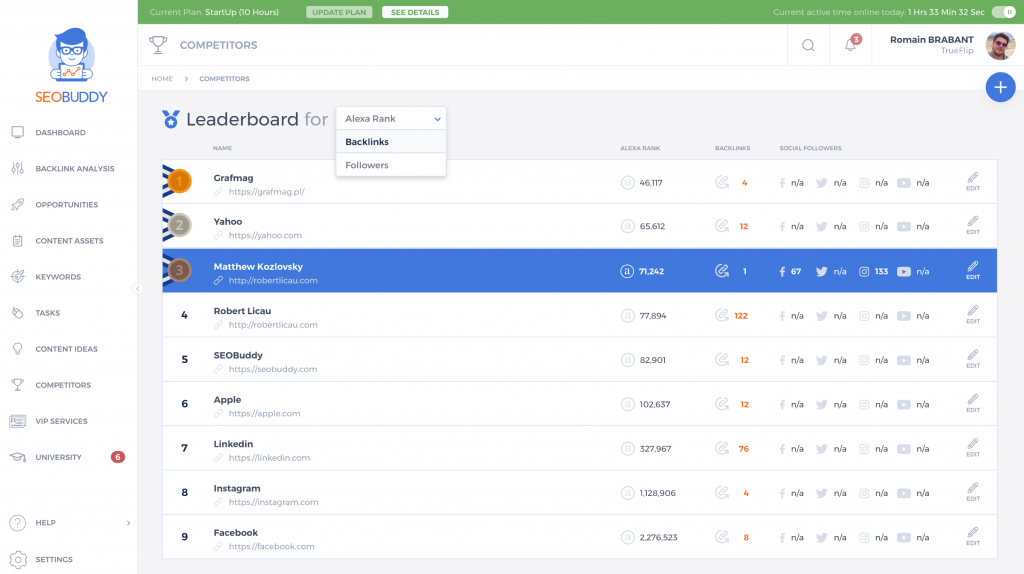
2. Understand their products and service
Now that you know your competitors (at least at a first glance!), let’s see what’s actually behind their name and website. 🧐 Look at each company at a time, browse through their offer and pricing, and try to understand how they operate!
- Maybe you’ll unveil a new trend, 🙃
- Perhaps you might find a new hot product to sell, 😎
- Or you’ll discover a new service to promote! 🥳
While doing your SERP Analysis with SEO Buddy, you can take notes using the sticky notepad to keep track of all your discoveries. All your notes will be neatly organized in your SEO Buddy account.
3. Analyze their content and detect new content ideas
In this step, you might now ask why? I’m not even having a blog?
Well, you should start one then. 😉
Truth is – a lot of times it is not your competitor’s websites listing in the top 10 results.
I give you an example: If I google the (for me highly relevant) keyword “pitch deck” – it is not company websites or product/service pages dominating the first result page.
Instead, it is articles about:
- “What is a Pitch Deck”
- “30 Legendary Startup Pitch Decks”
- “How to Create a Pitch Deck”
- “Pitch Deck examples”
- and so on…
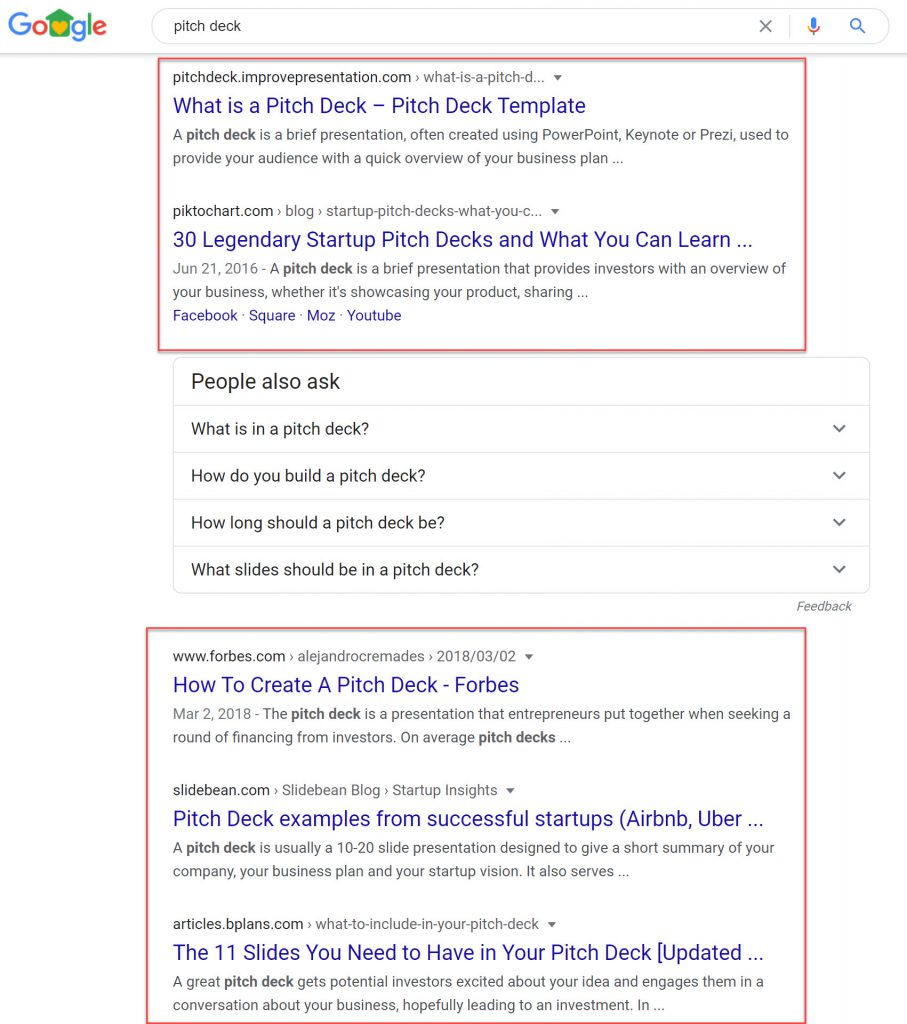
I can SEO-optimize my website as much as I want to – it will NEVER rank in the top results if I don’t produce the right content. Why? Because Google learned what the search intent behind that query is and tries to serve the “searchers” exactly what they are looking for. 🔍
Sure – if someone googles my name: “Magdalena Reith” they will find my page immediately. But to be realistic – how would they know that I even exist in the first place, let alone that I offer a service they might be interested in?
This is why it is EXTREMELY important to create content that people are actually looking for and that Google sees as relevant for a certain search query.
Think about it: If someone looks for the term “pitch deck”, chances are that he or she is working on their own investor presentation.
On top, it means that he or she is looking for guidance!
Which in turn means, he or she might be interested in my service.
Jackpot – that person is in my target group. 🎯
Now, that I understood my competitive landscape by looking at the top results, I can work on producing a relevant piece of content according to the search intent behind my keyword.

And finally, try to rank as high as possible high with it!
Looking at the top results will also help you answer questions such as “How do my competitors market themselves?” “Do they have a blog?” If yes, what are their topics?
This information can be extremely valuable to source own content ideas for your marketing or blog activities.
SEO Buddy, for example, lets you tag relevant websites as “Content idea” while doing your SERP Analysis and allows you to further categorize them according to content type and category.
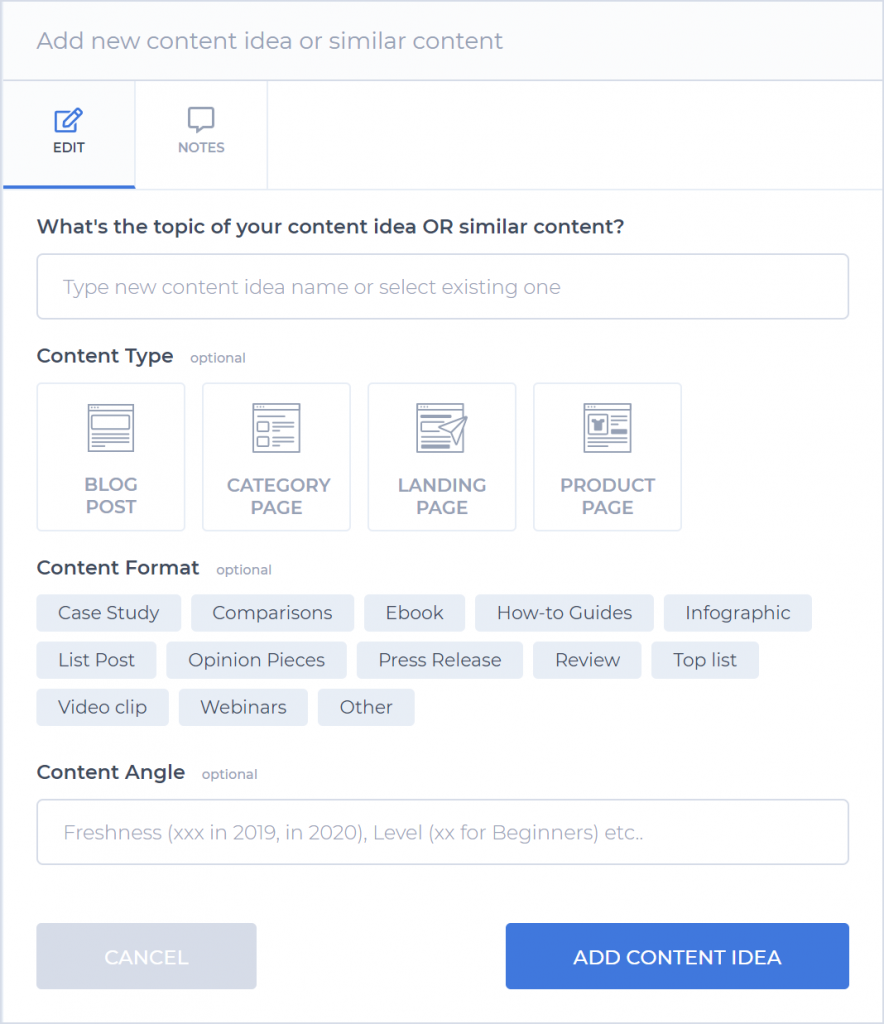
Now, all these juicy content ideas are neatly organized in your content pipeline.
It’s time to share your findings with your team (or clients) and set your content production goal for the months to come (and finally climb the ladder of Google Search Results with a military-grade strategy!)
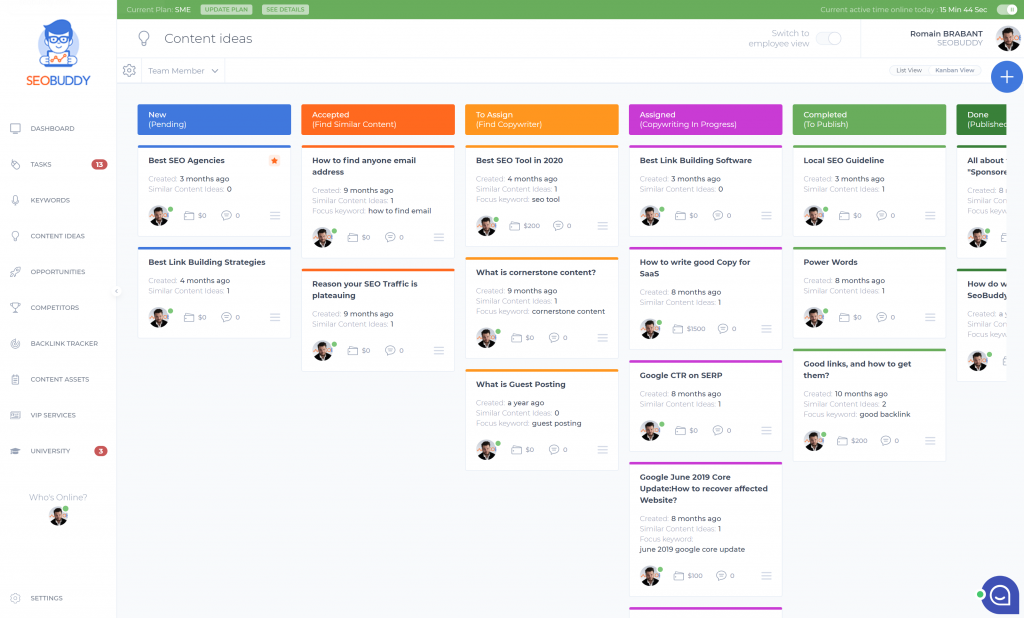
4. Unveil relevant backlink opportunities
So far, we have used the SERP analysis to discover new competitors, service and product ideas, processes, pricing, or content ideas.
And there’s more! Doing a good SERP analysis will always provide a great source for ultra-relevant backlink opportunities. 😍
In case you didn’t know – backlinks are one of the most important factors Google uses to determine the “rank-worthiness” of a website – the more backlinks the better!
But: Not all backlinks are equal. Linking to your friend’s blog and vice versa creates a backlink for both of you -that is correct. However, this backlink is not as relevant as one on a page ranking in the same industry or – even better – a backlink on a page ranking for the keyword you are targeting!
What you are aiming for is earning backlinks from highly relevant websites in your industry.
“Funny”, you might now say “I have a small, relatively unknown business. How do I end up getting a backlink from a relevant page?”

Well, try to aim for the low-hanging fruits! Most of the top-ranking pages might not even be from your competitor or a famous blog! Look out for:
- a question on a forum, Quora, Reddit, where you can provide your expertise,
- maybe there is new a directory to list your business?
- a blog post where you can make a constructive comment?
- a “Top10” list, reviewing your competitor but not yet mentioning you?
- a story that deserves to be updated with a link to your content.
- and so on!
Be creative! 🙃
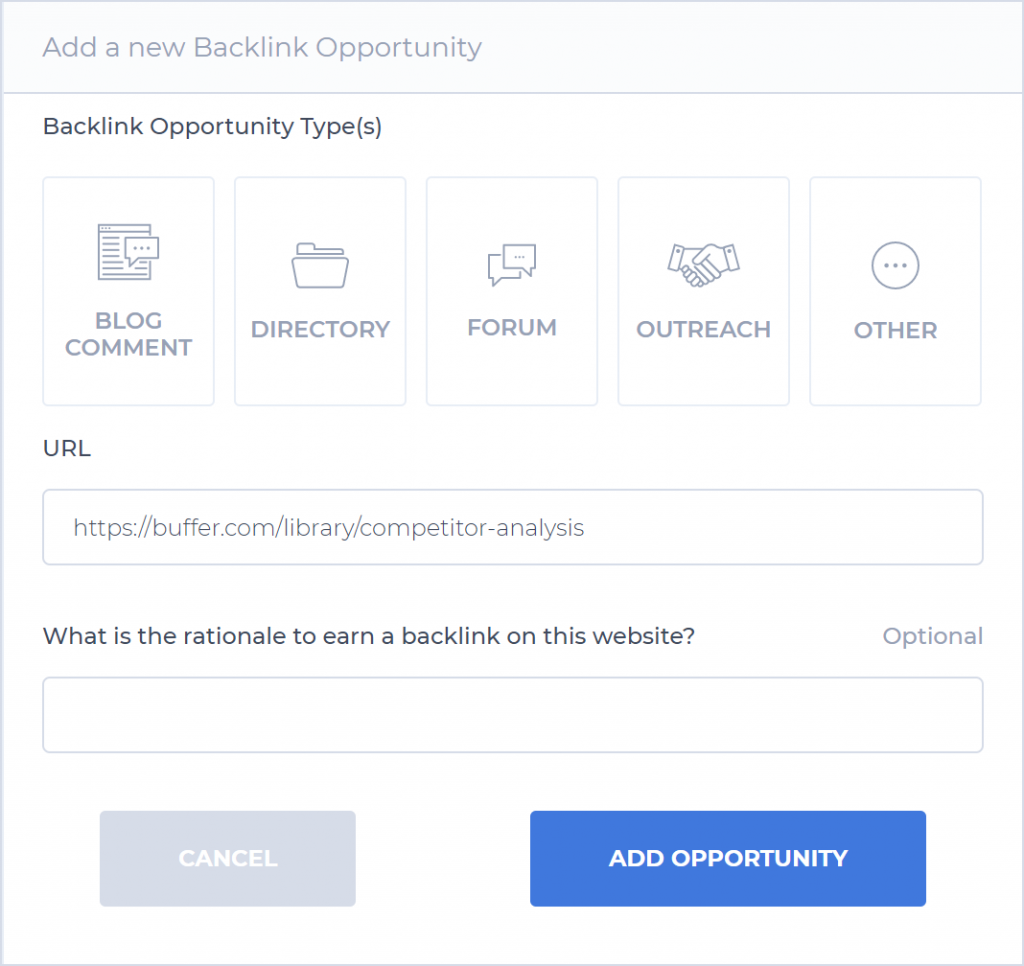
While (to be realistic) it is highly unlikely that you will be placed directly on your competitors’ websites, they can still be very helpful to identify other opportunities!
If you share the same target group and it makes sense to them to appear on certain webpages, blogs, directories or forums it might make sense for you as well.
SEO Buddy for example offers you the possibility to specifically categorize identified opportunities while doing the SERP Analysis, and document insights as well as corresponding follow-up tasks.
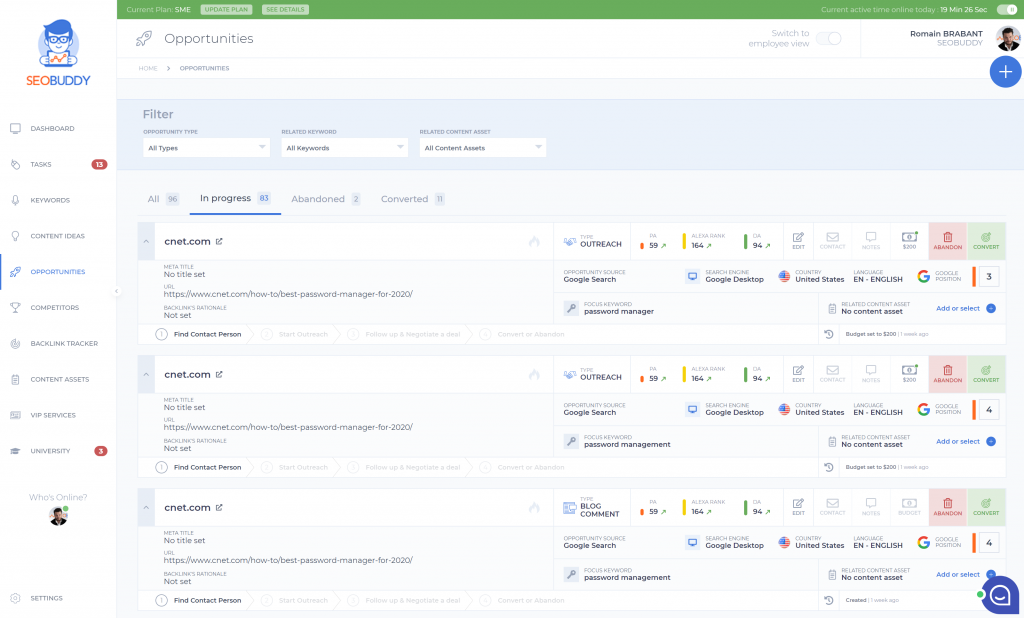
5. Identify their strengths and weaknesses and compare them to your own
After going through your competitors and documenting all relevant information about their portfolio and content production, it is time to evaluate!
Who is good at what? Make sure you understand each competitor to their core and see what best practices you can extract for your own business! Maybe you even detect partnership or collaboration opportunities!
A common (and useful) concept for this part is the well-known SWOT analysis. For the ones that never heard about it before – the framework differentiates between the clusters “Strengths”, “Weaknesses”, “Opportunities” and “Threats”.
Once again it would exceed the scope of this article to explain the tool in detail – if you would like to deepen your knowledge on how to work a SWOT analysis, I can recommend you check out this article.
As you can see, there is a LOT of useful information to be discovered in a SERP analysis.
Big question: When am I done? How many competitors and websites should I go through? Quality over quantity! If you are looking for a specific number that is “enough” – well there is none. However, make sure you choose an amount that you are comfortable with.
It does NOT generate benefit to have 300 competitors but no time or motivation to analyze them in-depth. Instead, start with 5-10 and increase the number after you have thoroughly worked through this first batch.
Work with the newly gained insights!
Congratulations! You have come a long way. Now that you have all the data, make sure to act on it! Otherwise your previous work was a waste of time.
Data alone is nothing without action!
Now it’s time to use the information and insights gained and start organizing tasks on how to make the most out of them! Plan outreach initiatives, plan participating in relevant communities, implement best practices, adjust prices, produce new content or include special offers into your portfolio!
Tip: Break down tasks to small “to-dos”, such as
“Answer 3 questions in forum XY”
or
“Identify contact emails and reach out to three relevant backlink opportunities” within a certain amount of time.”
Smaller tasks are easier to digest and make you feel accomplished. 😇
Also, make sure to not lose the overview as you are likely working with a large amount of data. A tool like SEO Buddy can help you to keep the big picture in mind: It offers you a way to organize and monitor your tasks and progress, lets you add and allocate team members and even enables you to track the time spent on each task and category.
You might now say, well that’s great – once I have been through this process I’m probably done for a good time.

Well, not exactly!

How often should you conduct a Competitive Analysis?
Did you know that Google updates its index 9 times per day – meaning it re-ranks search results on a constant basis?

While the top results tend to be more stable than the lower-ranking area, this means that a competitor that ranked within the top 10 results today can potentially be replaced by someone else tomorrow. And that someone else might have a full new spectrum of relevant content ideas and new information.
Why?
We live in a time of information overflow – new content comes up every day. Today’s news will be history tomorrow. New forum questions come up every day – and google pushes them to the top.
Well, it’s pretty clear that nobody has time (and nerves!) to start evaluating search results every day. But missing out and losing potential is also not an option.
Tip: In order to stay up to date you should restart the analysis approximately once a month. However, in order to not miss out on the changes in between (and potentially uber-relevant SEO opportunities), use a tool such as SEO Buddy that captures all results on a daily basis and adds relevant opportunities to your “to be reviewed stack”.
Here is a good example:
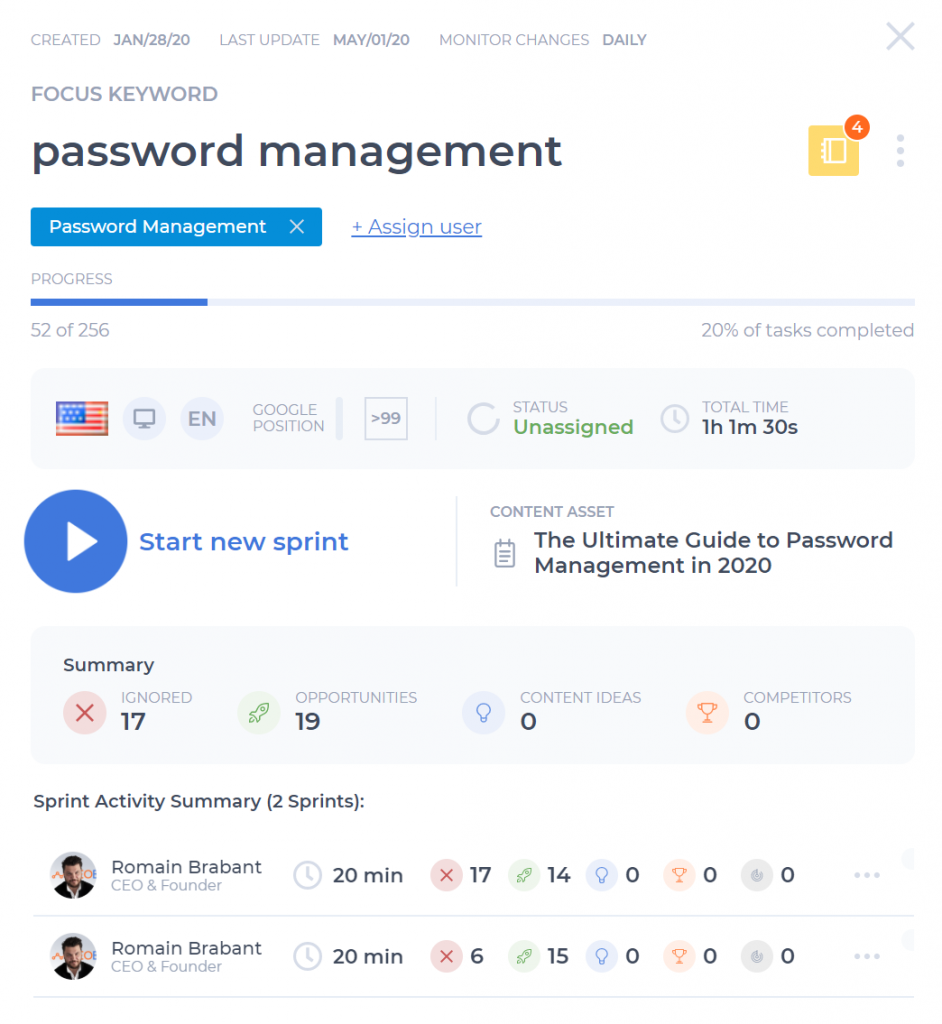
The task above was created on January 28th, 2020, for the Keyword “Password Management”. Every day, SEO Buddy fetches the first 100 results from Google SERP. After 3 months, these tasks grew from 100 results to 256 results – most of them being relevant backlinks opportunities (Forum post, News article on security, questions on Quora, Reddit, and more…)

Now it’s time to discover the other 102 steps that will get more organic traffic flowing to your website. Get the SEO Checklist here.
Want to get a sneak peek of what it looks like?
Enter your email and get a free demo version of the SEO Checklist.
So, how do I go from here?

All in all, we have noticed that a competitive analysis is a highly relevant and critical concept that should ideally be conducted once a month if possible. While that sounds a lot, there are tools such as SEO Buddy out there that make your life A LOT easier: Not only by helping you to find and manage relevant opportunities but also by making sure you keep the overview and can manage your tasks efficiently – in a team or alone. Let me quickly summarize the most important reasons why you should dump your excel spreadsheet for this specific matter (even though I’m usually a huge fan of it):
1. All-in-One Management tool!
Manage and monitor your efforts efficiently, keep the overview and track your overall progress in one simple application. Easy. Transparent. Efficient.
2. Don’t miss out!
Tools make sure you do not miss out on relevant opportunities. They include competitors that only rank for a certain time and list them in your “to be reviewed stack” even after they are gone. Extremely helpful!
3. Use our virtual location!
Did you know that search results vary depending on your location? If you’re in Germany you might face completely different search results than if you search the United States region for example. And it makes sense – often competition varies widely across borders. However, especially in these digital times, competitors are relevant even if they are on the other side of the world! Tools like SEO Buddy let you choose the region you are interested in, even if it is not congruent with your current location.
4. Work on it together!
Most of the time you’re not alone but work in a team. Use a tool to efficiently and transparently collaborate with others on your competitive analysis! And if you are the one holding the reins for this project: Tools allow you to manage and monitor your team and their progress efficiently, assign tasks and track time spent.
So, what are you waiting for?
It’s time to strip down your competitive landscape! Be observant and proactively work on your standing in the market instead of closing your eyes and waiting to be boiled! 🐸
And if you give it a go, make your life easy and try a tool for guidance and support – SEO Buddy lets you sign up for free and you can use all features of the tool completely free of charge and without any obligation for one week!

Want to rank higher, but are always busy? We’ll help you find and train a virtual assistant to do the work for you. Or you can use our full SEO agency service.
Book a free SEO strategy session today to discover what’s possible.






This is really informative. Great work!!
Looking forward to the next posts!!
Thank you Gaurav! If you like this post, don’t forget to subscribe to our newsletter.
Wow that’s really impressive. Each and every point is well described. Thank you for this wonderful article.
Thanks Raaz. I hope it will deliver value to your business.
This was an excellent article. Thanks so much for writing it.
Thanks Byron for such a nice comment
Comprehensive Guidelines on Competitive Analysis. Each and Every corner of Competitive Analysis is Discussed Excellently. SEO is Impossible Without Competitive Intelligence Gathering. Thanks a Lot for Sharing the Knowledge.
Great article, some very useful thing!
SEO is so much more than just keywords…